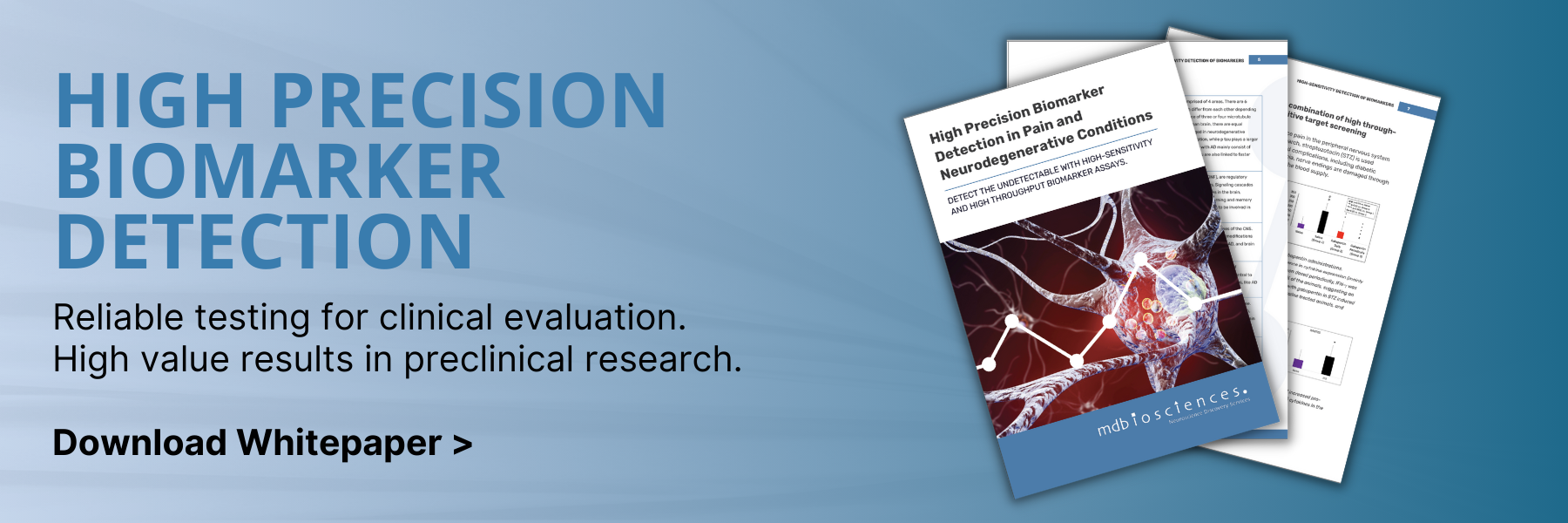
Increase value early in drug development with Biomarkers
Biomarkers have emerged as transformative tools in neuroscience drug development, reshaping the landscape of preclinical research and clinical applications. High-throughput screening and ultra-sensitive immunoassays now detect low levels of analytes in CSF, plasma, or serum, offering analytical measures to provide a deeper understanding of mechanism of action and how to treat and prevent neurological diseases.
Assays for detecting and evaluating biomarkers in preclinical studies:
-
- Flow Cytometry
- Multiplex Analysis
- Single Molecule Counting
- Immunohistochemistry
- Histological analysis
- Electrophysiology
- Behavioral analysis
Neuro-Specific Markers
Neuroscience is one of the largest and fastest growing focus areas in drug development. Biomarkers play a role throughout the entire drug development life cycle, providing insights for drug developers and clinicians on diagnosis, treatment, and prognosis for many debilitating conditions. Drug developers can incorporate many target biomarkers, mechanism biomarkers, and disease biomarkers into preclinical studies to objectively measure physiological processes, pathophysiological processes, or pharmacological responses.
|
Neurofilament Light Chain |
Neurofilament light (NFL) is a protein expressed in myelinated axons that reflectsthe level of axonal damage in the central or peripheral nervous systems. NFL is released into the CSF or blood following axonal damage and is an indicator of disease progression. NFL is typically elevated in neurodegenerative or neuropathic pain conditions. |
|
Alpha- Synuclein |
Alpha-synuclein (SNCA), specifically its phosphorylated form pS129, is involved in the misfolding process of neurodegenerative diseases and is a key marker of Parkinson’s and Alzheimer’s Disease. The protein has previously been detected in plasma in humans, but high sensitivity is needed to detect levels of SNCA pS129. |
|
Tumor Necrosis Factor |
Tumor necrosis factor alpha (TNFa) is an inflammatory cytokine that plays a role in the nervous system. This marker regulates myelination, BBB permeability, plasticity, and neurogenesis, and can also contribute to neuroinflammation and neuronal damage. |
|
IFNγ |
Interferon gamma is a proinflammatory cytokine that is produced by peripheral immune cells and under certain conditions, is produced by central nervous system (CNS) cells such as microglia, astrocytes, dorsal root ganglion neurons, and cerebrovascular endothelial cells. It activates glial cells and influences the CNS function in several ways. IFNg in the brain is elevated in certain neurodegenerative conditions, like Multiple Sclerosis. Dysregulation of IFNg has been implicated in the pathogenesis of neuropsychiatric disorders such as depression. |
|
Phospho-Tau Phospho-Tau (Thr181) Total Tau
|
Tau is a microtubule-associated protein that is comprised of 4 areas. There are 6 main isoforms expressed in the human brain, which differ from each other depending on the number of amino acid inserts and the presence of three or four microtubule binding repeat inserts (3R and 4R). In the normal human brain, there are equal amounts of 3R and 4R tau, but this ratio is often changed in neurodegenerative diseases. Total tau is a general marker of neurodegeneration, while p tau plays a larger role in AD progression. Neurofibrillary tangles associated with AD mainly consist of tau in the hyperphosphorylated state. High t tau and p tau are also linked to faster cognitive decline. |
|
BDNF
|
Neurotrophins, such as brain-derived neurotrophic factor (BDNF), are regulatory factors that mediate the differentiation and survival of neurons. Signaling cascades initiated by BDNF are key regulators of a wide range of processes in the brain, including synaptic plasticity, which plays an important role in learning and memory function. Changes in BDNF levels and activities have been shown to be involved in neurodegenerative conditions such as AD, PD, HD, and ALS. |
|
UCHL1
|
Ubiquitin C-terminal hydrolase L1 is one of the most abundant enzymes of the CNS. It plays a significant role in neuronal cell function and its variants and modifications have been linked to several neurodegenerative disorders including PD, AD, and brain injury. |
|
GFAP |
Glial fibrillary acidic protein (GFAP) is the signature intermediate filament of astrocytes, which form an integral part of the blood-brain barrier and are central to normal syanpse function. GFAP levels increase in neurodegenerative diseases, like AD and PD. |
|
Amyloid Beta 1-40 & 1-42 |
Amyloid-beta peptides form the plaques that associated with Alzheimer’s Disease. These peptides are cleaved by amyloid precursor proteins into a momomeric form, resulting in different lengths. This process leads to neurotoxicity. There are two main isoforms (Ab 1-40 and Ab 1-42) that have been identified as biomarkers for AD. |
|
SNAP-25 |
Synaptosomal-associated protein 25 (SNAP-25) is essential for cognitive function due to its key role in vesicular exocytosis. It is associated with amyloid pathology and has emerged as a potential biomarker of synaptic degeneration associated with AD in particular. |
Examples of Measuring NFL Levels
NfL is a valuable biomarker in stroke for evaluating axonal injury and ischemic brain damage. Elevated NfL levels correspond to axonal damage, offering insights into the condition's severity and progression. Similarly, NfL levels can be measured in chemotherapy-induced neuropathic pain because chemotherapy drugs can cause damage to peripheral nerves, leading to axonal injury and subsequent release of NfL into the bloodstream.

Middle cerebral artery occlusion (MCAO) model of stroke: NfL levels were elevated in MCAO treated animals compared to control or naive animals 24 hours following occlusion.
To learn more about our capabilities, contact us or download our Whitepaper below.
Related Posts
3 ways to improve clinical relevance of preclinical CNS data
The success rate from first candidate to market launch is less than 1%, requiring approximately 22...
The Critical Role of Clinical Relevance in Effective Study Design
Enhancing clinical relevance in early-stage studies can improve efficiency, reduce costs, and...
Successfully Predict Neuropathic Pain Conditions
The rodent has historically been used as the dominant model for the study of pain mechanisms and...




